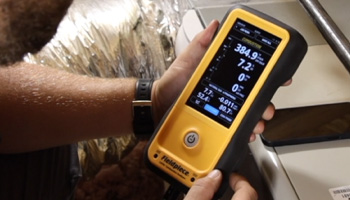
The purpose of combustion analysis is to help HVAC technicians ensure fuel-fired heating appliances are running safely and efficiently. Long gone are the days of checking efficiency by the color and shape of the flame. Combustion analyzers measure and calculate a range of variables such as flue temperature, draft pressure, and the byproducts of combustion like oxygen (O2), carbon dioxide (CO2) and carbon monoxide (CO). To tap into the full power of your combustion analyzer, here are a few tips and best practices to keep in mind this heating season.
Location, Location, Location
Combustion analysis is all about location. Key measurements are taken in the flue gas after the heat exchanger and prior to any dilution air entering the flue. Typically, the ideal location to measure combustion byproducts, such as CO, is about a foot above the furnace box and at least a foot away from any elbow. Using an existing combustion test access fitting is preferred over drilling into the flue. If an access location must be drilled, reseal the hole following testing with a silicone plug for example, to ensure exhaust gases are not vented into the surrounding space. Silicone is resistant to heat and moisture in the flue, providing a sure seal. When you insert the probe, use a cone lock to hold the sampling tip in the center of flue, at the hottest point.
Warm-up
The best practice is to warm up and insert the combustion analyzer probe prior to firing up the furnace. All measurements should be monitored at start-up, after a system has stabilized and after light out (unit turned off). The analyzer should be turned on and allowed to warm up in fresh air, in order to zero the ambient CO sensor. Avoid starting the analyzer near the exhaust pipe of a service van, or in the furnace room. After the start-up tests, it’s also important to let the furnace run for a few minutes to stabilize before measuring combustion performance.
Monitoring Carbon Monoxide (CO)
During the installation or service of a heating appliance, the fuel and airflow are adjusted to maximize combustion efficiency and safety. If the adjustments allow too much fuel or too much oxygen into the reaction, the imbalance will lead to incomplete combustion. When this happens, it can create a dangerous amount of CO. While you should always defer to the furnace manufacturer’s recommendations and local regulations, what follows are a few key tips when monitoring CO levels.
After the burners light, the CO should rise and fall and the O2 should slowly fall, and both should stabilize within a few minutes. If the CO or O2 levels spike suddenly after the blower starts on a warm air furnace, it is a sign the heat exchanger is compromised in some way. If the CO sensor oversaturates, immediately bring the probe into fresh air, and let the analyzer pump run until the CO displayed level is at or near zero.
Combustion Analyzer Maintenance
To keep your combustion analyzer ready for every heating season job, there are a few recommended maintenance tips. Always drain the analyzer water trap (if applicable) and check the dust filter regularly. When testing is complete, run the pump until CO, O2 and temperature readings return to ambient, removing any residuals from the sensors and analyzer. Also, when you’re powering the combustion analyzer down, ensure the probe has cooled to ambient temperature before inserting it into the carrying case. And finally, it is recommended that sensors be calibrated annually or as required by local regulations.
Let Your Combustion Analyzer Do the Work
A combustion analyzer is a powerful tool to help you keep fuel-fired heating appliances running efficiently and safely. Therefore, the biggest tip is that combustion analysis should be the first and last thing completed during any heating appliance repair. The outlined tips not only help ensure peak performance, but they help you prioritize safety and the use of best practices in your analysis procedures.